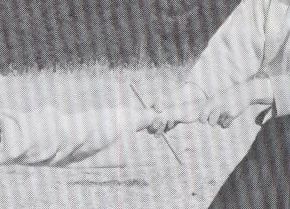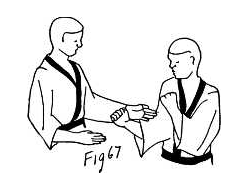Stuck in my files is an article on the kongo that I never seem to have time to finish, so today I thought I would post part of it.
Keep It Simple
99% of the time the only techniques you will need for using the kongo are the strikes.
However, the reader is doubtless curious about “fancy stuff” such as locks, so I’ll include some discussion of these in today’s blog, with the caution that it is better to keep things simple but effective in a real fight.
Some of these techniques are “pain compliance” techniques so their effectiveness will vary between individuals and situations.
For information on sensitive areas and “pressure points” a kubotan or kongo may be used against, purchase “Attack, Avoid, Survive”.
Know Your Bones

Most of the locks described here are applied against the bones of the forearm.
The forearm has two long bones, the one on the upper/thumb side being the radius and the lower bone the ulna. You can remember these by knowing they are alphabetical from top to bottom, R above U.
Locks should be applied so that the pressure is applied against either the ulna or the radius, depending on situation.
Force is applied against a single bone rather than distributed to several will be more effective.
Force is applied to these bones at the ends where they joint the hand.
Squeeze around this area with your fingers and you will soon locate where the more sensitive areas lie.

In the following description my main intent is to convey the mechanical principles of how these locks work.
For that reason I’ve generally described the positioning of the kongo/kubotan first. Many of the locking techniques are easier with the longer, thinner kubotan.
In practice, it is more likely that the opponent’s arm would first be gripped by the non-weapon hand and the weapon then brought into position.
To avoid such unwieldy terms as “strong side thumb” or “weak side fingers” the following descriptions will all assume that the kongo is being used in the right hand.
The Pincer or V-Locks
Hold your kongo/kubotan so several inches project from the top of the forefinger side of your hand.
You may have to shift your grip slightly from that normally used for striking.
At the same time, stick out your thumb so kongo and thumb form a sort of “V”. We will call this configuration “the pincer” and use it as the basis for learning the following locks.
The pincer itself is a pretty good technique. Grasp the foe’s thumb between your thumb and the kongo and apply pressure, using the weapon as a fulcrum. This can be performed against other fingers too. Or, use your pincer to take hold of the subject’s ear or other fleshy body part.
There are several other variations of the pincer-based locks. It is possible to hold the wrist, fingers or thumb in the pincer and use the left hand to assist in some other way such as manipulating the foe’s hand or thumb.
J-Locks
Put your right hand in pincer form and slip your right thumb under the foe’s wrist so the kongo passes over the top. Slip the thumb of your left hand over the free end of the kongo and pass your left fingers under your opponent’s wrist.
This is the basic mechanism of the lock but in practice it is more likely that you would first grip the foe’s wrist with your left hand and then bring the kongo into position under the thumb.
This technique can also be applied against the thumb. The opponent’s thumb is clamped between right thumb and kongo and your left hand grasps his wrist and hooks your left thumb over the free end of the kongo.
A related technique against the wrist is performed in the same way but does not place the right thumb under the wrist. The kongo is laid across the bone and the free end taken by the left thumb.
Disadvantage of this variation is that the kongo must not be allowed to slip around the wrist. Maintain the relative position of your hands so the kongo/kubotan lies level across the bone.
The advantage of this technique is it can be applied in situations where the thumb could not be easily slipped under the wrist.
I call this family of locks the “J-locks” since the kubotan forms the crossbar of the J while the fingers of the other hand form the curved section around the wrist.
Depending on the relative orientation of the arm these locks can also be applied against the ulna.
Delta or Gasket Locks
Instead of taking the free end of the kongo with the left thumb, it is also possibly to wrap the left fingers around the kongo and slip the left thumb around the wrist.
You therefore have eight fingers pulling against the kongo and two thumbs pushing into the wrist.
Takayuki Kubota (inventor of the kubotan) stresses that when using this technique the web of the thumbs should form a tight “gasket seal” against the suspect’s arm. The advantage of this technique is that it can be applied to either surface of the arm.
As well as placing the kubotan across the upper side of the wrist and the thumbs underneath, you can place the kubotan under the wrist and push down on the upper surface with your thumbs.
I think of this lock as the “Delta lock” since the two hands and the kubotan form a triangle,
X-Locks
Like the delta-locks, the X-locks create a triangle around the opponent’s wrist.
Hold the kubotan like a wand. This hold is easily assumed from the pincer. Alternately, an “ice-pick” hold may be used with the longer length of the kubotan projecting from the little finger side of the hand.
Place your arm so the forearm crosses over the opponent’s arm. Hook the kubotan across the end of the radius or ulna on the far side of the arm.
Grasp the free end of the kubotan with the other hand so your forearms cross. The kubotan and your wrists form a triangle around the arm.
Reorient the opponent's arm as necessary and move your elbows apart so your wrists are scissored tightly around the opponent's wrist/forearm. Pressure may be increased by adding a rolling action to the wrists.
Eda Koppō
Many of the techniques shown in the book are variations of those already described but one is worth dealing with separately
Slip your fingers through the loop of the kongo as though you were going to strike with it and open your hand.
Place this hand on your foe’s forearm near the wrist so that the kongo either crosses the ulna or the radius.
The fingers encircle the wrist and the kongo is sandwiched between your palm and the foe’s arm, pressing onto the bone.
The other hand can be used to assist.
How effective this will be will depend on several factors, including the diameter and shape of your kongo, strength of your grip and the pain sensitivity of your foe.
For this reason my personal inclination would be to use this technique on the ulna if there is a choice, which seems to be the more sensitive of the two bones.
The advantage of this technique is that it can be applied with your kongo in the normal striking position and does not need your grip to be shifted so can be rapidly applied against a target of opportunity.

Suppose you are using a kongo without a finger loop or an object as improvised weapon? Brace it by placing your little finger and thumb under the object and your other three fingers on top (shown above).
You can also brace it between your thumb and second finger with the fore finger on top. This is a good technique for a longer, thinner object such as a pencil.

A final trick. Place your kubotan, kongo or pencil between any of the subject’s fingers, then squeeze the fingers together.
You probably have a pen or pencil nearby as you are reading this.
Try it out on yourself.








